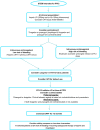Optimal pharmacological therapy in ST-elevation myocardial infarction-a review : A review of antithrombotic therapies in STEMI
- PMID: 29687412
- PMCID: PMC5967999
- DOI: 10.1007/s12471-018-1112-6
Optimal pharmacological therapy in ST-elevation myocardial infarction-a review : A review of antithrombotic therapies in STEMI
Abstract
Antithrombotic therapy is an essential component in the optimisation of clinical outcomes in patients with ST-elevation myocardial infarction (STEMI) undergoing primary percutaneous coronary intervention. There are currently several intravenous anticoagulant drugs available for primary percutaneous coronary intervention. Dual antiplatelet therapy comprising aspirin and P2Y12 inhibitor represents the cornerstone treatment for STEMI. However, these effective treatment strategies may be associated with bleeding complications. Compared with clopidogrel, prasugrel and ticagrelor are more potent and predictable, which translates into better clinical outcomes. Therefore, these agents are the first-line treatment in primary percutaneous coronary intervention. However, patients can still experience adverse ischaemic events, which might be in part attributed to alternative pathways triggering thrombosis. In this review, we provide a critical and updated review of currently available antithrombotic therapies used in patients with STEMI undergoing primary PCI. Finding a balance that minimises both thrombotic and bleeding risk is difficult, but crucial. Further randomised trials for this optimal balance are needed.
Keywords: Antithrombotic therapy; STEMI.
Conflict of interest statement
R.S. Hermanides, S. Kilic and A.W.J. van’t Hof declare that they have no competing interests.
Figures




Similar articles
-
Antithrombotic therapy for patients with STEMI undergoing primary PCI.Nat Rev Cardiol. 2017 Jun;14(6):361-379. doi: 10.1038/nrcardio.2017.18. Epub 2017 Feb 23. Nat Rev Cardiol. 2017. PMID: 28230176 Review.
-
Safety and Efficacy of Triple Therapy With Ticagrelor or Prasugrel Versus Clopidogrel After Percutaneous Coronary Intervention for ST-Elevation Myocardial Infarction.J Cardiovasc Pharmacol Ther. 2021 Nov;26(6):625-629. doi: 10.1177/10742484211031436. Epub 2021 Jul 8. J Cardiovasc Pharmacol Ther. 2021. PMID: 34236915
-
Current Status and Future Direction of Antithrombotic Therapy for Patients with STEMI Undergoing Primary PCI.Rev Cardiovasc Med. 2022 Sep 5;23(9):297. doi: 10.31083/j.rcm2309297. eCollection 2022 Sep. Rev Cardiovasc Med. 2022. PMID: 39077705 Free PMC article. Review.
-
Optimal Antithrombotic Therapy for Patients with STEMI Undergoing PCI at High Risk of Bleeding.Curr Atheroscler Rep. 2019 Apr 17;21(6):22. doi: 10.1007/s11883-019-0782-x. Curr Atheroscler Rep. 2019. PMID: 30997584 Review.
-
Optimizing adjunctive antithrombotic and anticoagulant therapy in primary PCI for STEMI.Minerva Cardioangiol. 2016 Jun;64(3):238-55. Epub 2016 Mar 2. Minerva Cardioangiol. 2016. PMID: 26934662 Review.
Cited by
-
Short-term efficacy of ticagrelor in acute ST-segment elevation myocardial infarction patients undergoing an emergency percutaneous coronary intervention.Aging (Albany NY). 2019 Oct 30;11(20):8925-8936. doi: 10.18632/aging.102353. Epub 2019 Oct 30. Aging (Albany NY). 2019. PMID: 31665124 Free PMC article. Clinical Trial.
-
The Importance of Hemostasis on Long-Term Cardiovascular Outcomes in STEMI Patients-A Prospective Pilot Study.J Clin Med. 2025 Aug 5;14(15):5500. doi: 10.3390/jcm14155500. J Clin Med. 2025. PMID: 40807121 Free PMC article.
-
Influences of different dose of tirofiban for acute ST elevation myocardial infarction patients underwent percutaneous coronary intervention.Medicine (Baltimore). 2020 Jun 5;99(23):e20402. doi: 10.1097/MD.0000000000020402. Medicine (Baltimore). 2020. PMID: 32501985 Free PMC article.
-
PTEN inhibitor improves vascular remodeling and cardiac function after myocardial infarction through PI3k/Akt/VEGF signaling pathway.Mol Med. 2020 Nov 19;26(1):111. doi: 10.1186/s10020-020-00241-8. Mol Med. 2020. PMID: 33213359 Free PMC article.
-
Large intracoronary thrombus and its management during primary PCI.Indian Heart J. 2020 Nov-Dec;72(6):508-516. doi: 10.1016/j.ihj.2020.11.009. Epub 2020 Nov 19. Indian Heart J. 2020. PMID: 33357638 Free PMC article. Review.
References
-
- O’Gara PT, Kushner FG, Yancy CW, et al. 2013 ACCF/AHA guideline for the management of ST elevation myocardial infarction: a report of the American College of Cardiology Foundation/American Heart Association Task Force on Practice Guidelines. J Am Coll Cardiol. 2013;61:485–510. doi: 10.1016/j.jacc.2012.11.018. - DOI - PubMed
-
- Levine GN, Bates ER, Ting HH, et al. 2011 ACCF/AHA/SCAI guideline for percutaneous coronary intervention. A report of the American College of Cardiology Foundation/American Heart Association Task Force on Practice Guidelines and the Society for Cardiovascular Angiography and Interventions. Circulation. 2011;124:574–651. doi: 10.1161/CIR.0b013e31823ba622. - DOI - PubMed
-
- Ibanez B, James SK, Widimský P, et al. 2017 ESC Guidelines for the management of acute myocardial infarction in patients presenting with ST segment elevation. Eur Heart J. 2017 - PubMed
-
- Windecker S, Kolh P, Witkowski A, et al. 2014 ESC/EACTS Guidelines on myocardial revascularization: the Task Force on myocardial revascularization of the European Society of Cardiology (ESC) and the European Association for Cardio-Thoracic Surgery (EACTS) developed with the special contribution of the European Association of Percutaneous Cardiovascular Interventions (EAPCI) Eur Heart J. 2014;35:2541–2619. doi: 10.1093/eurheartj/ehu278. - DOI - PubMed
Publication types
LinkOut - more resources
Full Text Sources
Other Literature Sources
Miscellaneous

